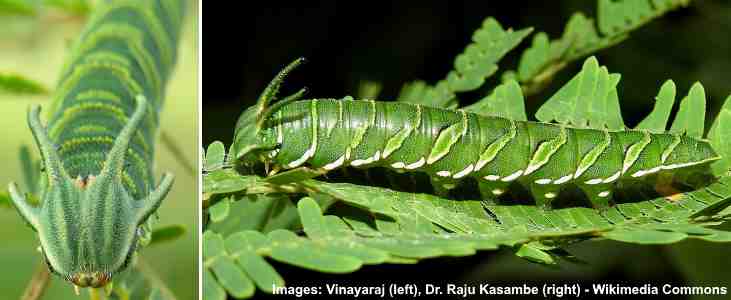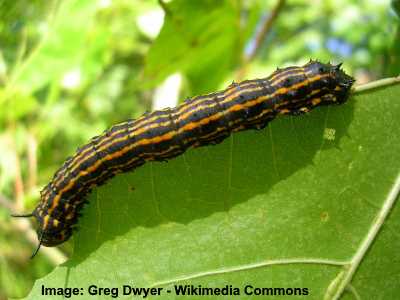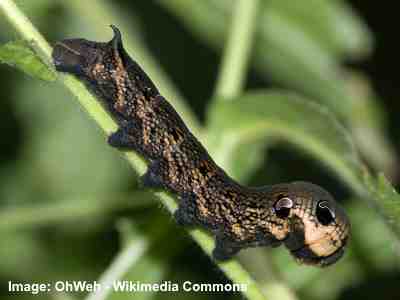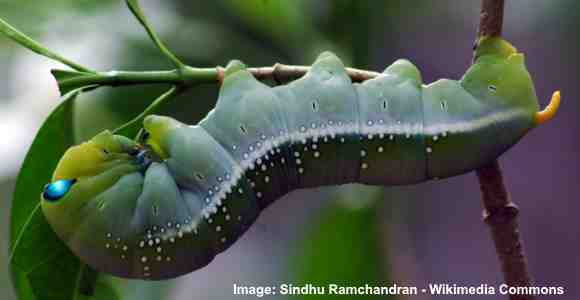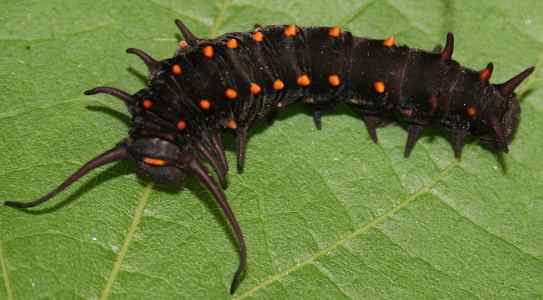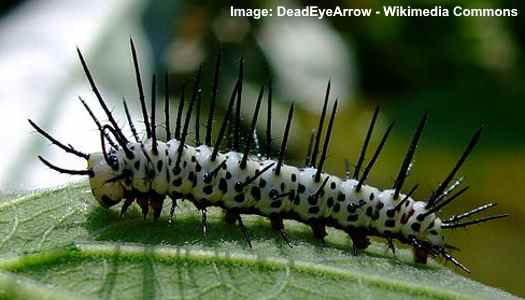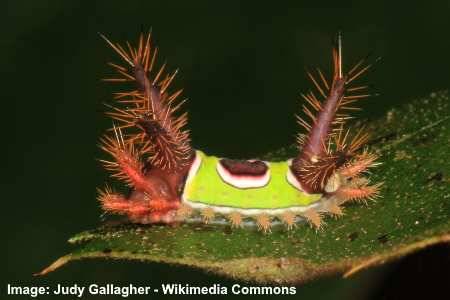Horned Caterpillars: Tomato Hornworm, Dragon Headed Caterpillar, and More
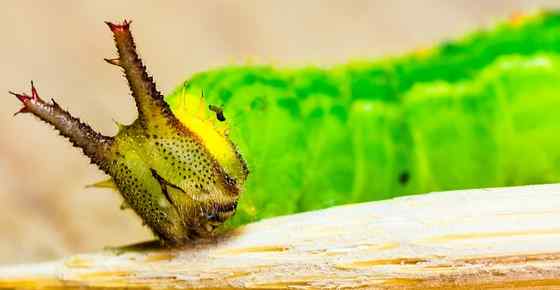
Horned caterpillars are crawling insects which are the larvae of moths and butterflies. The “horns” on some types of caterpillars are used in defense to ward off potential predators. Some types of hornworms have a horn-like tail that they wag to frighten other animals. Other horned caterpillars have spiky-looking structures giving the caterpillar a horned appearance.
All species of caterpillars, including horned ones, belong to the insect order Lepidoptera. Caterpillars start off as eggs before developing into larvae that look like fat worms. During their larval stage, caterpillars are voracious eaters and can increase their weight by thousands of times. Before turning into a moth or butterfly, caterpillars enter the pupal stage where metamorphous occurs.
Having horns is just one identifying feature of some caterpillars. Other types of caterpillars can be hairy, furry, or striped. Although green caterpillars are the most common type, horned caterpillars can also be black, yellow, or multicolored.
In this article, you will learn about the various kinds of horned caterpillars such as Dragon-Headed caterpillar, Tomato Hornworm, Hickory Horned Devil caterpillar and more. Pictures, descriptions of caterpillars, and their scientific names will help identify different caterpillar species.
Horned Caterpillar Identification
Identifying types of horned caterpillars is easy as you just have to look for the spiny structures that look like horns. In some species, caterpillars have a horn on their tail end. Some green caterpillars have a pair of horns on their heads. Other big caterpillars have spiky-looking horns on various parts of their bodies.
Identification of horned caterpillars is also possible by noting their markings and types of plants they feed on. Although horns on caterpillars can make them look scary, most horned caterpillars are not types of stinging caterpillars.
Types of Horned Caterpillars With Pictures and Common Names
Let’s look in more detail at the different kinds of fascinating horned caterpillars you may find in your garden or yard.
Dragon-Headed Caterpillar (Polyura athamas)
Looking like a long green slug, the dragon-headed caterpillar is identified by its 4 long curled horns on its head. The name “dragon-headed” caterpillar is appropriate as its head has a mythical dragon-look. Although its horns give this caterpillar a menacing look, this caterpillar is completely harmless and won’t sting you.
These green horned dragon caterpillars are native to Indonesia and central Asia.
After metamorphizing, the dragon-headed caterpillar turns into a beautiful butterfly. The brown chocolate-colored wings have yellow or cream-colored markings on them.
Horned caterpillar identification
A species of dark green caterpillar with 2 horns on either side of its head. It is distinguished by lateral creamy white stripes on its middle segments.
Tomato Hornworm (Manduca quinquemaculata)
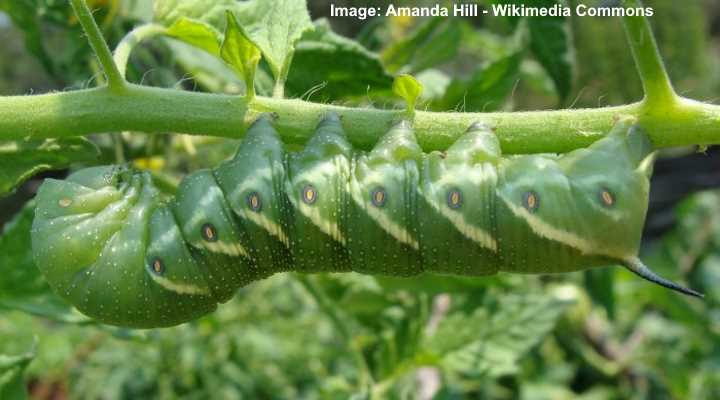
The large green tomato hornworm caterpillar has a horned tail and white markings
The tomato hornworm is a large lime-green colored caterpillar with a horned tail. Its common name comes from the fact that it gorges on tomato leaves. Because of their color, they can be difficult to spot as they blend into the color of the plants’ leaves. Another way to tell tomato moth caterpillars apart from other caterpillars is by is huge, oversized head.
Tomato hornworms have cream-colored markings along the side of its body. There are also eye-like markings that help to confuse predators. You will sometimes see tomato caterpillars raise up the front half of their bodies. This species of caterpillar is likely one of the largest caterpillars you will find in your garden.
Horned caterpillar identification
The fat slug-like tomato caterpillar has a protruding horn that looks like a spike at its rear end. You can identify the tomato hornworm by its V-shaped markings along its sides. These help to tell this species apart from the similar tobacco hornworm which has diagonal stripes.
How to control tomato hornworm caterpillars
Tomato hornworm moth caterpillars are not just a type of huge caterpillar, they are also a destructive garden pest. You will often find them munching through tomato and eggplant leaves as well as other plants from the nightshade family.
Because of their large size, the best way to get rid of tomato hornworms is to pick them off by hand. They are not poisonous and their tail horn doesn’t sting.
You can also use diatomaceous earth (DE) as natural, non-toxic pest control for caterpillars and other insects.
Hickory Horned Devil (Citheronia regalis)
With a name like the hickory horned devil, you would expect this caterpillar to look intimidating. This certainly lives up to its name with its “devil-like” appearance. The turquoise-green caterpillar has large red jagged curved horns on its head. You will also notice smaller black horns on each of its segments.
Growing up to 6” (15 cm) long and having a fierce appearance, you could be mistaken for thinking this is a dangerous caterpillar. However, this hickory horned devil a very placid and completely harmless caterpillar. You can find these huge slug-like caterpillars gorging on hickory, cotton, and hazel leaves.
The hickory caterpillar turns into the appropriately-named regal moth. This is a large species of moth that has a wingspan of up to 6” (15 cm). The wings of this orange moth have red striped markings and patches of white dots on them.
Horned caterpillar identification
Identified by its scary look and huge size, this is one of the largest caterpillars in the world. Look for its large red and black horns on its head and small black spines around its body sections.
Other Types of Horned Caterpillars
What are the other kinds of horned caterpillars that you are likely to come across? Here are some common caterpillars, including a poisonous variety of horned caterpillar.
Rosy Maple caterpillar (Dryocampa rubicunda)
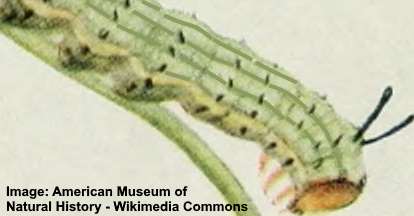
The rosy maple caterpillar has 2 black horns with light green and white striped body with black dots
This striped species of horned caterpillar is called the rosy maple moth caterpillar due to its preference for all types of maple trees. This crawling caterpillar is also called the “green-striped mapleworm.”
You can easily identify this striped caterpillar by its 2 jet black horns on its head. The fat slug caterpillar has greenish-white stripes running the length of its body. However, these may change in color in different stages (instars) of the larvae growth. Black dots running around the segments also help with caterpillar identification.
Horned caterpillar identification
To identify the rosy maple caterpillar, look for the light green-colored striped body, 2 black horns on its head, and smaller black spikes at its rear.
Orange Striped Oakworm (Anisota senatoria)
A type of stripy black caterpillar that has horns and tiny spikes is the orange striped oakworm. This caterpillar looks like a large long slug with orange stripes running its length. You will notice that these harmless caterpillars have 2 protruding horns at its head similar in appearance to the rosy maple caterpillar.
These hungry caterpillars are found feeding on oak tree foliage and are common in states such as Florida, Texas, and other southern states. After the pupal stage, striped oakworms turn into beautiful orange and pink moths.
Horned caterpillar identification
Growing to about (5 cm) long, you can easily identify these black caterpillars by their orange stripes, long antennae-like horns, and spiky rear end.
Monarch caterpillar (Danaus plexippus)
The monarch caterpillar has the unusual identifying feature of horns at either end of its body. You can distinguish between the head and tail end as the head has longer ‘antennae.’
The immature monarch butterfly larvae look completely different from the mature ones. When fully mature, monarch caterpillars have black, white, and yellow striped markings. Although the long horns look menacing, these are harmless caterpillars that don’t sting.
After the chrysalis stage, these feeding insects turn into monarch butterflies, which some regard as the most beautiful butterflies in the world.
Horned caterpillar identification
Easy to identify by the white, black, and yellow bands wrapping around each segment. Also, look for the presence of 2 longer horns at one end and 2 shorter ones at the other. You will also find these caterpillars feeding vivaciously on milkweed.
Tobacco Hornworm (Manduca sexta)
Species of caterpillar such as tobacco hornworm in the family Sphingidae are recognized by their single pointed horn-like tail. The big green luminous caterpillars have plump segmented bodies, and oversized head, and eye-like markings along its sides. As with many types of hornworms, it can be difficult to tell the head apart from its end.
Although it has the name ‘tobacco hornworm,’ these annoying garden pests also feed on tomato plants and eggplant leaves.
Horned caterpillar identification
Difficult to distinguish from tomato hornworms as they look similar. These green caterpillars are identified by the thin diagonal stripes on their segments. Tomato hornworms differ as they have V-shaped markings.
Elephant Hawk Moth Caterpillar (Deilephila elpenor)
The name of the elephant hawk caterpillar comes from the way its fat gray body looks like an elephant’s trunk.
When the larvae mature and reach 3” (7.6 cm), they are a brown-gray color with black dots along their sides. However, some species are a dark green type of caterpillar. The caterpillar’s horn is a small black or gray spike pointing out at its tail end.
Native to Europe, these dull-looking caterpillars turn into colorful pink and olive-colored moths.
Horned caterpillar identification
Large, smooth, gray-black caterpillars with large round markings near their head. To identify elephant hawk caterpillars, look for the small curving horn on the tail segment.
White Admiral Caterpillar (Limenitis arthemis)
The white admiral caterpillar is found in North America and is one of the more unusual looking caterpillars on this list. Two long spiky black horns protrude from one end of the caterpillar.
The unusual identifying feature is the brown and white patchy markings. This makes the caterpillar looks like bird droppings and it can disguise itself on a branch. You will usually find white admiral caterpillars feeding on birch, willow, cherry, and aspen trees.
After they emerge from the pupa, these are beautiful butterflies that are known for their blue iridescent colors.
Horned caterpillar identification
The irregularly shaped olive-brown and white body with 2 twig-like horns are the ways to identify this caterpillar species.
Oleander Hawk Moth Caterpillar (Daphnis nerii)
Like many green caterpillars in the family Sphingidae, these voracious leaf-eaters have a spiked horny tail at their rear. In some respects, oleander hawk caterpillars resemble tomato or tobacco hornworms.
These horned caterpillars have green bodies with a distinctive eye marking on their head, giving them a strange haunting look. The fat green “slugs” have large prolegs in their center segments. The caterpillars are also identified by a pale bluish line running the length of their sides and also bluish dots in random patterns.
Horned caterpillar identification
Look for the small curved pale orange horn at its tail end and brilliant blue eye markings at its head.
Blue Swallowtail Caterpillar (Battus philenor)
The swallowtail species of caterpillar contains a number of horned varieties of caterpillars. The blue swallowtail, or pipevine swallowtail, looks like it has horns sticking out all over it.
Looking at pictures of a blue swallowtail, you will see long protruding tubercles (horns) at one end of its long black body. There are also shorter horns sticking out of its sides and it has a line of small orange spikes on its back.
Another type of pipevine caterpillar from the same species is a blood-red color. Similar to the black species, its body seems to be covered in soft horns. Looking closely, you will see that both the black variety and the red one is covered in fine hairs.
Horned caterpillar identification
These caterpillars are identified by rows of soft horns (tubercles) and their bodies have a glossy, velvety appearance.
White-Lined Sphinx Horned Caterpillar (Hyles lineata)
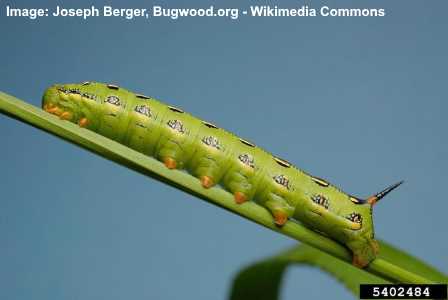
The white-lined sphinx caterpillar has yellow and black markings on its bright green body with a horn on its back
The white-lined sphinx has a protruding tail horn that is characteristic of many green caterpillars in the family Sphingidae.
There is a lot of variation in color with these horned caterpillars. Some types can have smooth black bodies with lines of orange dots. Other kinds of these sphinx caterpillars are lime green with multicolored dots that are red, yellow and black. Also, look for the 4 orange prolegs under the middle segments of its body.
Horned caterpillar identification
The identifying feature of the white-lined sphinx caterpillar is its orange horn at the back of the body. This spiky-looking protrusion can sometimes be yellow with a black tip and it doesn’t sting.
Rustic Sphinx Caterpillar (Manduca rustica)
The long, sharp-looking dark green horned tail is the first thing you notice about the rustic sphinx caterpillar. These light-green caterpillars are related to hornworms and other sphinx caterpillars.
The body is bright green and you will notice the segments are divided by diagonal light-colored lines. You will also notice small orange-red dots on the side of each segment and small black dots in between segments.
Horned caterpillar identification
To distinguish this horned caterpillar from other hornworms, look for granular bumps on its rear horn.
Zebra Longwing Caterpillar with Horns (Heliconius charithonia)
Commonly found in Texas, Florida, and Central America, zebra longwing caterpillars have sharp-looking horns sticking out in all directions. The caterpillars from the family Nymphalidae, have light-colored gray to white bodies.
The fascinating feature of zebra caterpillars is the 6 rows of very long spines. You will also notice that there are tiny jagged spikes on these horns. The black dots covering this unusual type of caterpillar just add to its fierce look.
Horned caterpillar identification
A light gray or light turquoise green body covered in black sharp-looking horns. Feeds on plants from the passionflower family.
Saddleback Horned Caterpillar (Acharia stimulea)
One of the most frightening horned caterpillars must be the saddleback caterpillar. This caterpillar looks menacing and for good reason, this is a stinging species of toxic caterpillar that can give a nasty “bite.”
The first thing you will notice is the plethora of horns on this creepy-looking caterpillar. There are a pair of thick horns at either end of the venomous caterpillar. These are covered in hairs that cause skin irritation when brushed against. There are also horn-like protrusions along the side of the saddleback.
The name saddleback comes from its unique markings. In fact, there is not another species of caterpillar similar to this one. The brown spiky caterpillar body has a lime green square patch on the back. There is a colored-circle in the middle which makes the caterpillar’s back look like a saddle.
Horned caterpillar identification
You can easily identify the saddleback horned caterpillar with it 4 large spiky horns on the head and tail end.
White-Marked Tussock Furry Horned Caterpillar (Orgyia leucostigma)
Another caterpillar that is instantly identifiable due to its unique look is the white-marked tussock. The “horns” on this scary-looking caterpillar are 2 large furry “antennae” at its front. There is also a large furry-looking tail at its end.
This caterpillar is also identified by its black body and tufts of white hairs. These hairy tufts appear on its back and along its sides. There are also red dots and yellow stripes on its back.
These furry horned caterpillars are common in many states in North America all the way from Texas and Florida to Alberta in Canada.
Horned caterpillar identification
Two long hairy ‘horns’ and a hairy tail that points upward along with white tufts of hairs are the identification features of this horned caterpillar.
Related articles:

